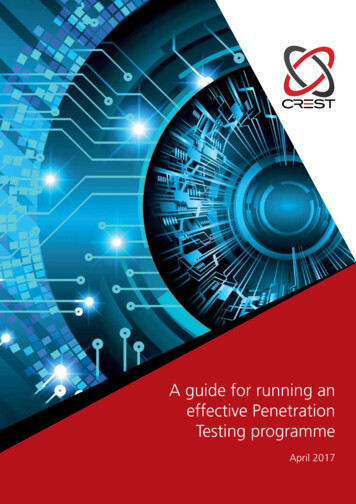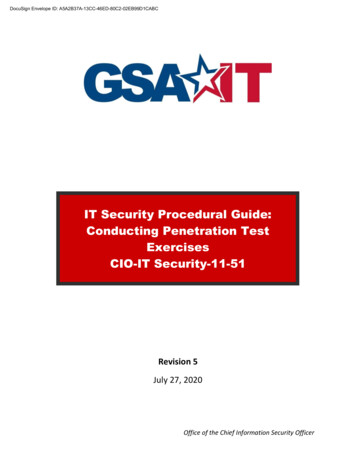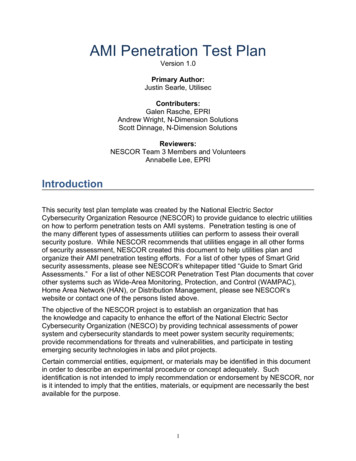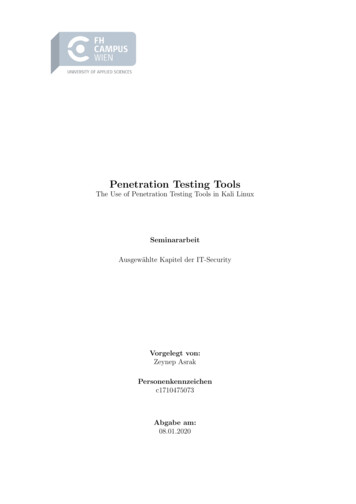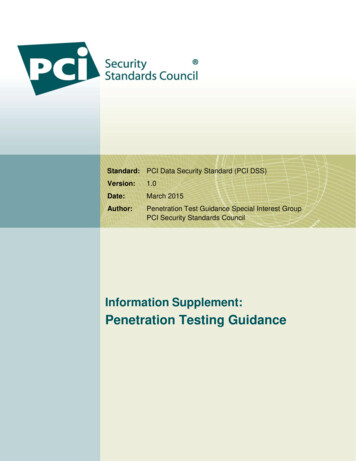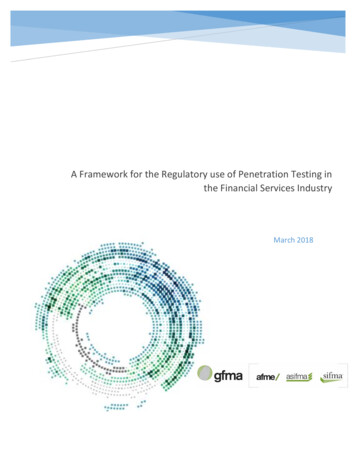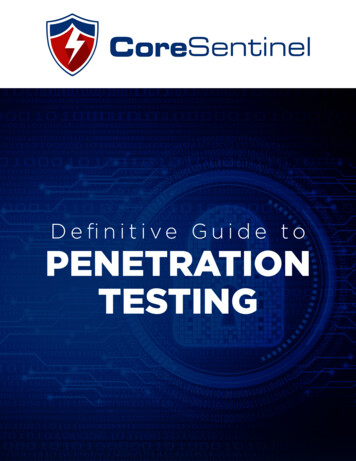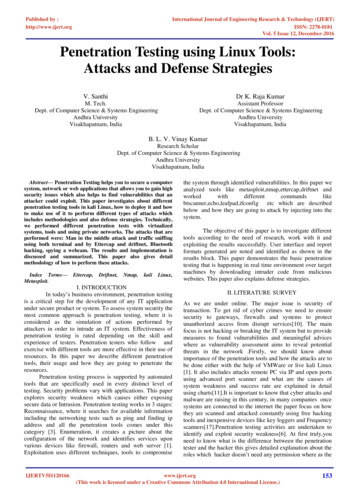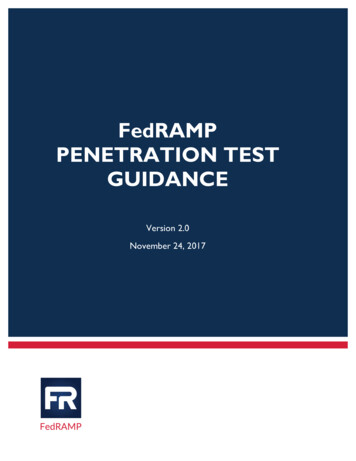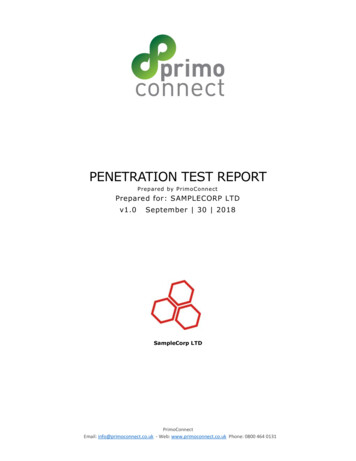
Transcription
PENETRATION TEST REPORTPrepared by PrimoConnectPrepared for: SAMPLECORP LTDv1.0September 30 2018SampleCorp LTDPrimoConnectEmail: info@primoconnect.co.uk - Web: www.primoconnect.co.uk Phone: 0800 464 0131
SampleCorp – Penetration Test ReportPrimoConnect0800 464 0131www.primoconnect.co.ukSAMPLECORP LTD123 North StreetLondon, N1 2AB01234 567 890www.samplecorp.comNo warranties, express or implied are given by PrimoConnect with respect to accuracy, reliability,quality, correctness, or freedom from error or omission of this work product, including any impliedwarranties of merchantability, fitness for a specific purpose or non-infringement. This document isdelivered "as is", and PrimoConnect shall not be liable for any inaccuracy thereof. PrimoConnect doesnot warrant that all errors in this work product shall be corrected. Except as expressly set forth in anymaster services agreement or project assignment, PrimoConnect is not assuming any obligations orliabilities including but not limited to direct, indirect, incidental or consequential, special or exemplarydamages resulting from the use of or reliance upon any information in this document. This documentdoes not imply an endorsement of any of the companies or products mentioned. 2018 PrimoConnect. All rights reserved. No part of this document may be reproduced, copied ormodified without the express written consent of the authors. Unless written permission is expresslygranted for other purposes, this document shall be treated at all times as the confidential and proprietarymaterial of PrimoConnect and may not be distributed or published to any third-party.PrimoConnectCommercial in confidence i
SampleCorp – Penetration Test ReportTABLE OF CONTENTSPrimoConnectDocument ControlivExecutive Summary1Test Scope1Results1Recommendations2Testing Approach3Overview3Discovery & Reconnaissance4Validation & Exploitation4Internal Network Findings5Scope5Network Penetration Testing Results5Services by Host and by Port5Vulnerability Summary Table8Details9Web Application Findings20Scope20Web Application Results20Web Application Detailed Findings21Vulnerability Summary Table21Details21Wireless Network Findings27Scope27Wireless Network Results27Access via Wi-Fi Penetration Testing Device27Wireless Network Reconnaissance27Wireless Network Penetration Testing28Mobile Applications Findings30Scope30Application Results30Application Detailed Findings30Vulnerability Summary Table30Details31Social Engineering Findings37Scope37Social Engineering Results37Social Engineering Detailed Findings38Email Exposure Report38Spear Phishing Report 138Commercial in confidence ii
SampleCorp – Penetration Test ReportPrimoConnectVoice Phishing Report40Malicious USB Payloads48Limitations & Risk Scoring50Limitations50Risk Rating Score Calculation50Risk Rating Scale51Appendix52Commercial in confidence iii
SampleCorp – Penetration Test ReportDOCUMENT CONTROLIssue ControlDocument Referencen/aProject Numbern/aIssue1.0Date30 October 2017ClassificationConfidentialAuthorName Of AuthorDocument TitleSampleCorp Penetration TestApproved byReleased byName Of TesterOwner DetailsNameName Of OwnerOffice/RegionContact Number01234 567 890E-mail Addressname@primoconnect.co.ukRevision HistoryIssueDateAuthor1.030 September2018Name Of AuthorPrimoConnectCommentsCommercial in confidence iv
SampleCorp – Penetration Test ReportEXECUTIVE SUMMARYPrimoConnect conducted a comprehensive security assessment of SampleCorp LTD in order todetermine existing vulnerabilities and establish the current level of security risk associated with theenvironment and the technologies in use. This assessment harnessed penetration testing and socialengineering techniques to provide SampleCorp management with an understanding of the risks andsecurity posture of their corporate environment.TEST SCOPEThe test scope for this engagement included three hosts on the company’s internal network, a businesscritical web application, as well as an internally-developed mobile application. In addition, SampleCorprequested a wireless audit be performed against their Wi-Fi infrastructure, to discover any insecurewireless protocols, unsecured networks, or related security issues. A social engineering assessment wasalso requested, to judge the responsiveness of company staff when facing a phishing attack.Testing was performed September 1 – September 21, 2018. Additional days were utilized to producethe report.Testing was performed using industry-standard penetration testing tools and frameworks, includingNmap, Sniper, Fierce, OpenVAS, the Metasploit Framework, WPScan, Wireshark, Burp Suite, Tcpdump,Aircrack-ng, Reaver, Asleap, and Arpspoof.RESULTSThe table below includes the scope of the tests performed, as well as the overall results of penetrationtesting these environments.Environment TestedTesting ResultsInternal NetworkCRITICALWireless NetworkLOWWeb ApplicationHIGHMobile ApplicationHIGHSocial Engineering ExercisesLOWTo test the security posture of the internal network, we began with a reconnaissance and host discoveryphase during which we used portscans, ARP scans, and OSINT tools to fingerprint the operating systems,software, and services running on each target host. After fingerprinting the various targets anddetermining open ports and services enabled on each host, we executed a vulnerability enumerationphase, in which we listed all potential vulnerabilities affecting each host and developed a list of viableattack vectors. Finally, in order to weed out false positives and validate any remaining vulnerabilities,we attempted to exploit all vulnerabilities affecting the target hosts. After comprehensive testing, onlya few vulnerabilities were discovered to be present in the target hosts, and we were ultimately unableto exploit these issues to compromise the confidentiality, integrity, or availability of any of the externalhosts in scope.PrimoConnectCommercial in confidence 1
SampleCorp – Penetration Test ReportMultiple Critical- and High- and Medium-severity issues were found affecting hosts on the SampleCorpinternal network, which require immediate remediation efforts in order to secure the company’senvironment against malicious attackers.To test the security posture of the wireless networks in scope, we performed a number of different scansand attempted a range of attacks. Through a rigorous analysis, we found no vulnerabilities affecting thewireless network configuration. The wireless networks have been configured and secured to a highstandard.To test the security of the company’s Android application, we attached a debugging and exploitationframework to a phone with the app installed. Serious security issues were found to affect the app, andwe suggest halting use of the app until it is either re-engineered in a more secure manner, or a suitablereplacement is found.To test the company’s preparedness and response to social engineering attacks, we began by utilizingOSINT techniques to scrape the company’s website and social media accounts for target emails. Next,we launched spear phishing campaigns using spoofed email addresses, voice phishing attacks, andphysical social engineering attacks using USB sticks loaded with malicious payloads. Although 35.7% ofthe targeted employees did end up responding to the phishing emails, none of the malicious USBs wereplugged in, and no one responded to the voice phishing messages. All in all, SampleCorp appearsrelatively prepared to defend against social engineering attacks.RECOMMENDATIONSThe following recommendations provide direction on improving the overall security posture ofSampleCorp’s networks and business-critical applications:1. Ensure that the credentials protecting the Glassfish instance on host 172.16.2.8 are of suitablecomplexity to prevent brute force attacks, or disable Secure Admin on the instance to preventremote access to the DAS.2. Disable Dynamic Method Invocation on host 172.16.2.8, if possible. Alternatively, upgrade toStruts 2.3.20.3, Struts 2.3.24.3 or Struts 2.3.28.1.3. Require authentication to use the WebDAV functionality on host 172.16.2.8.4. Restrict access to the distccd service on host 172.16.2.3 (UDP port 3632).5. Disable the “r” services or edit the .rhosts file to prevent remote access to host 172.16.2.3.6. Disable the "username map script" option in the smb.conf configuration file on host 172.16.2.3.7. Upgrade SLMail or mitigate risk by restricting access to the service on host 172.16.2.5.8. Update the Ninja Forms plugin to version 2.9.43 or higher on the web app located athttp://172.16.2.8:8585/wordpress/9. Increase the strength of the password for the “vagrant” administrator account on the web applocated at http://172.16.2.8:8585/wordpress/10. Ensure that the all content providers require strict permission for interaction on the Androidmobile app.11. Disable content provider access to the device’s underlying filesystem on the Android mobile app.PrimoConnectCommercial in confidence 2
SampleCorp – Penetration Test ReportTESTING APPROACHOVERVIEWAll testing was executed in several related phases.1. In the planning phase, the rules of engagement were identified, scope of testing and testwindows were agreed upon, and testing goals were set.2. The discovery phase included automated vulnerability scanning along with manual testing toexplore and understand the testing target and any vulnerabilities that could be detected byautomated tools.3. The attack phase comprised efforts to exploit any vulnerabilities detected, and to synthesizeknowledge gained about the environment, its technology, its users and its function into anescalation of privilege beyond that intended by the customer.4. The final phase recorded all findings in a manner that supports risk assessment and remediationby the customer. This included the writing of this n Testing MethodologyReportingAdditionally, the attack phase comprised several distinct steps, executed iteratively as information wasdiscovered.1. Gained access to the system or environment in a way that was not intended.2. Escalated privileges to move from regular or anonymous user to a more privileged position.3. Browsed to explore the newly accessed environment and identify useful assets and data.4. Deployed tools to attack further from the newly gained vantage point.5. Exfiltrated data.DiscoveryPhasePrimoConnectAttack ommercial in confidenceInstalledToolsExfiltratedData 3
SampleCorp – Penetration Test ReportDISCOVERY & RECONNAISSANCEAs the first step of this engagement, PrimoConnect performed discovery and reconnaissance of theenvironment. This included performing network or application scans; reviewing the system, network orapplication architecture; or walking through a typical use case scenario for the environment. The resultsof discovery and reconnaissance determine vulnerable areas which may be exploited.VALIDATION & EXPLOITATIONPrimoConnect used the results of the reconnaissance efforts as a starting point for manual attempts tocompromise the Confidentiality, Integrity and Availability (CIA) of the environment and the datacontained therein.The highest risk vulnerabilities identified were selectively chosen by the assessor for exploitationattempts. The detailed results of these exploitation and validation tests follow in the sections below.While PrimoConnect may not have had time to exploit every vulnerability found, the assessor chosethose vulnerabilities that provided the best chance to successfully compromise the systems in the timeavailable.PrimoConnectCommercial in confidence 4
SampleCorp – Penetration Test ReportINTERNAL NETWORK FINDINGSSCOPEThe following externally accessible IP addresses were within the scope of this engagement:Target IP Addresses172.16.2.8172.16.2.3172.16.2.5Testing was performed using industry-standard penetration testing tools and frameworks, includingNmap, Sniper, Fierce, OpenVAS, Metasploit Framework, Wireshark, and Burp Suite.NETWORK PENETRATION TESTING RESULTSResult ClassificationVulnerabilities FoundYesExploited – Denial of Service (DoS)NoExploited – Elevation of Privilege (EoP)YesExploited – Remote Code Execution (RCE)YesExploit Persistence AchievedYesSensitive Data ExfiltratedYesOverall RiskHIGHThere were a significant number of exploited vulnerabilities present on the external network target,including a vulnerability in the Oracle Glassfish server, a vulnerability in the Apache Struts REST Plugin,an unrestricted WebDAV upload vulnerability, misconfigured ‘r’ services, a vulnerability in the DistCCdaemon, a Samba RCE vulnerability, and a buffer overflow vulnerability in the SLMail application, all ofwhich led to system compromise of the affected hosts.Services by Host and by PortAs the first step in the Discovery phase, PrimoConnect conducted network reconnaissance on theprovided IP addresses to determine open ports. Each IP address was tested for all TCP and UDP portsby using standard scanning tools like Nmap and Sparta. The following ports were identified, and portswith exploitable vulnerabilities are highlighted.IP shOpenSSH 7.1(protocol 2.0)PrimoConnectCommercial in confidence 5
SampleCorp – Penetration Test Report172.16.2.3PrimoConnecttcp1671rmiregistryJava RMItcp3000httpWEBrick httpd1.3.1 (Ruby2.3.3 (201611-21))tcp4848ssl/httpOracleGlassFish 4.0(Servlet 3.1;JSP 2.3; Java1.8)tcp5985tcp8020httpApache httpdtcp8022httpApacheTomcat/CoyoteJSP engine 1.1tcp8027unknownunknowntcp8080httpOracleGlassFish 4.0(Servlet 3.1;JSP 2.3; Java1.8)tcp8282httpApacheTomcat/CoyoteJSP engine 1.1tcp8383httpApache httpdtcp8484httpJettywinstone-2.8tcp8585httpApache ticsearchREST API1.1.1 (name:Spymaster;Lucene 4.7)tcp21ftpvsftpd 2.3.4tcp22sshOpenSSH4.7p1 DebianCommercial in confidenceMicrosoftHTTPAPI httpd2.0(SSDP/UPnP) 6
SampleCorp – Penetration Test Report8ubuntu1(protocol 2.0)172.16.2.5PrimoConnecttcp25smtpPostfix smtpdtcp53domainISC BIND 9.4.2tcp80httpApache httpd2.2.8((Ubuntu)DAV/2)tcp111rpcbind2 (RPC#100000)tcp139netbios-ssnSamba smbd3.X - 4.X(workgroup:WORKGROUP)tcp445netbios-ssnSamba tkit-rshrexecdtcp513login?tcp514shellNetkit rshdtcp2121ftpProFTPD esqlPostgreSQL DB8.3.0 - 8.3.7tcp5900vncVNC (protocol3.3)tcp8009ajp13Apache Jserv(Protocol v1.3)tcp21ftpFreeFloat ftpd1.00tcp25smtpSLmail smtpd5.5.0.4433tcp80httpApache cial in confidence 7
SampleCorp – Penetration Test Reporttcp110pop3BVRP SoftwareSLMAIL pop3dtcp443ssl/httpApache osoftTerminalServiceudp3632distccdVulnerability Summary TablePrimoConnect strongly recommends that the following vulnerabilities be remediated, whether exploitedor not, as they represent unnecessary risk to the organization’s overall security posture.#Vulnerability SummaryRisk LevelRecommendations1Sun/Oracle GlassFish Server AuthenticatedCode ExecutionCRITICALEnsure that the credentialsprotecting the Glassfish instanceare suitably complex. SecureAdmin can also be disabled on theinstance to prevent remote accessto the DAS.2Apache Struts REST Plugin with DynamicMethod Invocation Remote Code ExecutionHIGHDisable Dynamic MethodInvocation if possible. Alternativelyupgrade to Struts 2.3.20.3, Struts2.3.24.3 or Struts 2.3.28.1.3Unauthenticated WebDAV UploadMEDIUMRequire authentication to use theserver’s WebDAV functionality.4DistCC Daemon Command ExecutionCRITICALRestrict access to the distccdservice on UDP port 36325Misconfigured “r” Services VulnerabilityCRITICALDisable the “r” services or edit the.rhosts file to prevent remoteaccess6Samba "username map script" CommandExecutionMEDIUMDisable the "username map script"option in the smb.confconfiguration file.7Seattle Lab Mail 5.5 POP3 Buffer OverflowHIGHUpgrade SLMail or mitigate risk byrestricting access to the service.PrimoConnectCommercial in confidence 8
SampleCorp – Penetration Test ReportDetails1. Sun/Oracle GlassFish Server Authenticated Code scriptionUnspecified vulnerability in Oracle Sun GlassFish Enterprise Server 2.1, 2.1.1, and 3.0.1, and SunJava System Application Server 9.1, allows remote attackers to affect confidentiality, integrity, andavailability via unknown vectors related to Administration.Two Metasploit modules exist which can be used to exploit this vulnerability.ObservationsUsing the auxiliary/scanner/http/glassfish login Metasploit module, weattempted to either bypass the authentication controls protecting theGlassfish instance or bruteforce the login credentials. Our attempt atauthentication bypass failed, but we did successfully bruteforce theadministrator credentials to the instance:PrimoConnectCommercial in confidence 9
SampleCorp – Penetration Test ReportNext, using these credentials, we successfully exploited the vulnerabilityin Glassfish to get remote code execution and obtain a shell with SYSTEMprivileges:PrimoConnectCommercial in confidence 10
SampleCorp – Penetration Test ReportImpactCVSS Score10.0Confidentiality Impact: Complete (There is total information disclosure, resulting in all systemfiles being revealed.)Integrity Impact: Complete (There is a total compromise of system integrity. There is a completeloss of system protection, resulting in the entire system being compromised.)Availability Impact: Complete (There is a total shutdown of the affected resource. The attackercan render the resource completely unavailable.)Access Complexity: Low (Specialized access conditions or extenuating circumstances do not exist.Very little knowledge or skill is required to exploit.)Authentication: Not required (Authentication is not required to exploit the vulnerability.)RecommendationsEnsure that the credentials protecting the Glassfish instance are of suitable complexity to preventbrute force attacks. In addition, Secure Admin can be disabled on the instance to prevent remoteaccess to the DAS in order to mitigate this topics/security/cpuapr2011-301950.html2. Apache Struts REST Plugin with Dynamic Method Invocation Remote Code ptionApache Struts 2.3.20.x before 2.3.20.3, 2.3.24.x before 2.3.24.3, and 2.3.28.x before 2.3.28.1,when Dynamic Method Invocation is enabled, allow remote attackers to execute arbitrary code viavectors related to an ! (exclamation mark) operator to the REST Plugin.A Metasploit module exists which can be used to exploit this vulnerability.ObservationsUsing the exploit/multi/http/struts dmi rest exec Metasploit module, wesuccessfully exploited the Apache Struts vulnerability to get remote codeexecution and obtain a shell with SYSTEM privileges:PrimoConnectCommercial in confidence 11
SampleCorp – Penetration Test ReportImpactCVSS Score: 7.5Confidentiality Impact: Partial (There is considerable informational disclosure.)Integrity Impact: Partial (Modification of some system files or information is possible, but theattacker does not have control over what can be modified, or the scope of what the attacker canaffect is limited.)Availability Impact: Partial (There is reduced performance or interruptions in resourceavailability.)Access Complexity: Low (Specialized access conditions or extenuating circumstances do not exist.Very little knowledge or skill is required to exploit.)Authentication: Not required (Authentication is not required to exploit the vulnerability.)Vulnerability Type(s): Execute CodeRecommendationsDisable Dynamic Method Invocation if possible. Alternatively upgrade to Struts 2.3.20.3, Struts2.3.24.3 or Struts 90960PrimoConnectCommercial in confidence 12
SampleCorp – Penetration Test Report3. Unathenticated WebDAV tionThe target host has WebDAV enabled, and does not require authentication to upload files to theserver.ObservationsWE were able to upload a PHP reverse shell to the server and execute it,which granted us shell access to the target host:ImpactCVSS Score: 7.5Confidentiality Impact: Partial (There is considerable informational disclosure.)Integrity Impact: Partial (Modification of some system files or information is possible, but theattacker does not have control over what can be modified, or the scope of what the attacker canaffect is limited.)Availability Impact: Partial (There is reduced performance or interruptions in resourceavailability.)Access Complexity: Low (Specialized access conditions or extenuating circumstances do not exist.Very little knowledge or skill is required to exploit.)Authentication: Not required (Authentication is not required to exploit the vulnerability.)Vulnerability Type(s): Execute CodeRecommendationsRequire authentication to use the server’s WebDAV x.php/Unrestricted File Upload4. DistCC Daemon Command scriptionPrimoConnectCommercial in confidence 13
SampleCorp – Penetration Test Reportdistcc 2.x, as used in XCode 1.5 and others, when not configured to restrict access to the serverport, allows remote attackers to execute arbitrary commands via compilation jobs, which areexecuted by the server without authorization checks.A Metasploit module exists to exploit this vulnerability.ObservationsUsing the exploit/unix/misc/distcc exec Metasploit module, we were able togain a command shell with root privileges on the target host:ImpactCVSS Score: 9.3Confidentiality Impact: Complete (There is total information disclosure, resulting in all systemfiles being revealed.)Integrity Impact: Complete (There is a total compromise of system integrity. There is a completeloss of system protection, resulting in the entire system being compromised.)Availability Impact: Complete (There is a total shutdown of the affected resource. The attackercan render the resource completely unavailable.)Access Complexity: Medium (The access conditions are somewhat specialized. Some preconditionsmust be satisfied to exploit)Authentication: Not required (Authentication is not required to exploit the vulnerability.)Gained Access: AdminPrimoConnectCommercial in confidence 14
SampleCorp – Penetration Test ReportVulnerability Type(s): Execute CodeRecommendationsRestrict access to the distccd service on UDP port 3632, or remove this service entirely from 004-2687/http://distcc.samba.org/security.html5. Misconfigured “r” Services 2,513,514DescriptionTCP ports 512, 513, and 514 are known as "r" services, and have been misconfigured to allowremote access from any host (a standard ".rhosts " situation). An attacker can easily log as rootvia these services, completely compromising the target host.ObservationsWe used the rlogin utility to gain access to the host with rootprivileges:PrimoConnectCommercial in confidence 15
SampleCorp – Penetration Test ReportImpactCVSS Score: 9.3Confidentiality Impact: Complete (There is total information disclosure, resulting in all systemfiles being revealed.)Integrity Impact: Complete (There is a total compromise of system integrity. There is a completeloss of system protection, resulting in the entire system being compromised.)Availability Impact: Complete (There is a total shutdown of the affected resource. The attackercan render the resource completely unavailable.)Access Complexity: Medium (The access conditions are somewhat specialized. Some preconditionsmust be satisfied to exploit)Authentication: Not required (Authentication is not required to exploit the vulnerability.)Gained Access: AdminVulnerability Type(s): Execute CodeRecommendationsConsider the benefits of removing these services from the host. If they are necessary for businessfunctions, then edit the .rhosts file to prevent remote access from any 1/805-7229/remotehowtoaccess-3/index.html6. Samba "username map script" Command iptionThe MS-RPC functionality in smbd in Samba 3.0.0 through 3.0.25rc3 allows remote attackers toexecute arbitrary commands via shell metacharacters involving the (1) SamrChangePasswordfunction, when the "username map script" smb.conf option is enabled, and allows remoteauthenticated users to execute commands via shell metacharacters involving other MS-RPCfunctions in the (2) remote printer and (3) file share management.ObservationsWe used the exploit/multi/samba/usermap script Metasploit module toexploit the vulnerable Samba service and obtained a shell with rootprivileges:PrimoConnectCommercial in confidence 16
SampleCorp – Penetration Test ReportImpactCVSS Score: 6.0Confidentiality Impact: Partial (There is considerable informational disclosure.)Integrity Impact: Partial (Modification of some system files or information is possible, but theattacker does not have control over what can be modified, or the scope of what the attacker canaffect is limited.)Availability Impact: Partial (There is reduced performance or interruptions in resourceavailability.)Access Complexity: Medium (The access conditions are somewhat specialized. Some preconditionsmust be satistified to exploit)Authentication: Single system (The vulnerability requires an attacker to be logged into the system(such as at a command line or via a desktop session or web interface).)Gained Access: UserVulnerability Type(s): Execute CodeRecommendationsDisable the "username map script" option in the smb.conf configuration abilities/display.php?id 534PrimoConnectCommercial in confidence 17
SampleCorp – Penetration Test 7.html7. Seattle Lab Mail 5.5 POP3 Buffer ionMultiple buffer overflows in SLMail 5.1.0.4420 allows remote attackers to execute arbitrary code via(1) a long EHLO argument to slmail.exe, (2) a long XTRN argument to slmail.exe, (3) a long stringto POPPASSWD, or (4) a long password to the POP3 server.A Metasploit module exists to exploit this vulnerability.ObservationsWe used the exploit/windows/pop3/seattlelab pass Metasploit module triggera buffer overflow in the Seattle Lab Mail application and obtained a shellwith SYSTEM privileges:ImpactCVSS Score: 7.5Confidentiality Impact: Partial (There is considerable informational disclosure.)PrimoConnectCommercial in confidence 18
SampleCorp – Penetration Test ReportIntegrity Impact: Partial (Modification of some system files or information is possible, but theattacker does not have control over what can be modified, or the scope of what the attacker canaffect is limited.)Availability Impact: Partial (There is reduced performance or interruptions in resourceavailability.)Access Complexity: Low (Specialized access conditions or extenuating circumstances do not exist.Very little knowledge or skill is required to exploit. )Authentication: Not required (Authentication is not required to exploit the vulnerability.)Gained Access: UserVulnerability Type(s): Execute CodeOverflowRecommendationsNGSSoftware alerted SLMail to most of these issues in early 2003 and a patch through an upgradehas been released. See http://www.slmail.com for more details. If upgrading is not an option thenNGSSoftware recommends that steps be taken to mitigate the risk by only allowing access to thePOPPASSWD and POP3 server from "inside" the firewall. "External" access can be provided allowingclients to connect via an authenticated VPN to the DMZ and then to the POP services from tps://marc.info/?l bugtraq&m 105232506011335&w 2PrimoConnectCommercial in confidence 19
SampleCorp – Penetration Test ReportWEB APPLICATION FINDINGSSCOPEThe scope of the web application testing of the engagement included the Wordpress application locatedat http://172.16.2.8:8585/wordpress/. The application is a business-critical corporate web site usedprimarily for scheduling and recording meeting notes.Testing was performed using industry-standard penetration testing tools and frameworks, includingNmap, WPScan, Wireshark, and Burp Suite.WEB APPLICATION RESULTSResult ClassificationVulnerabilities FoundYesExploited – Denial of Service (DoS)NoExploited – Elevation of Privilege (EoP)NoExploited – Remote Code Execution (RCE)YesExploit Persistence AchievedNoSensitive Data ExfiltratedNoOverall RiskHIGHA vulnerable Wordpress module allowed remote code execution leading to a command shell on theserver, and simple scanning also discovered a weak administrator username and password combination,which granted the ability to edit PHP code on the website and gain access to a command shell on theserver.OWASP 2013 Top 10A1InjectionA2Broken Authentication and Session ManagementA3Cross-Site Scripting (XSS)A4Insecure Direct Object ReferencesA5Security MisconfigurationA6Sensitive Data ExposureA7Missing Function Level Access ControlA8Cross-Site Request Forgery (CSRF)A9Using Components with Known VulnerabilitiesA10Unvalidated Redirects and Forwards- Critical,PrimoConnectResult- High,- Medium,- Low,Commercial in confidence- None 20
SampleCorp – Penetration Test ReportWeb Application Detailed FindingsPrimoConnect strongly recommends that the f
Testing was performed September 1 – September 21, 2018. Additional days were utilized to produce the report. Testing was performed using industry-standard penetration testing tools and frameworks, including Nmap, Sniper, Fierce, OpenVAS, the Metasploit Framework, WPScan, Wireshark, Burp S

